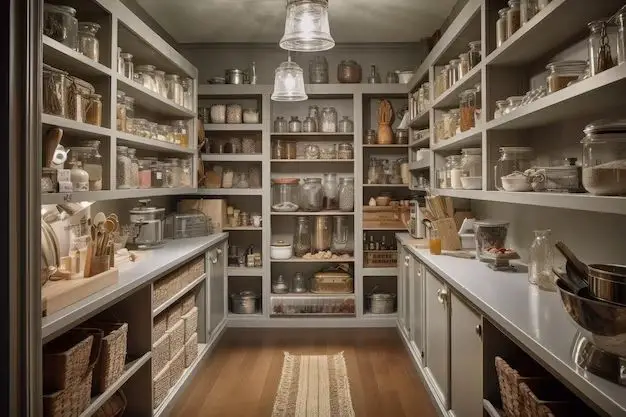A hidden pantry, also known as a secret pantry or concealed pantry, is a pantry that is built into the architecture of a home and concealed behind cabinetry or walls. Hidden pantries have become more popular in recent years as homeowners look for creative ways to maximize kitchen storage in limited space.
Page Contents
There are a few main types of hidden pantries:
- Walk-in pantry – A large, room-sized pantry concealed behind a door or seamlessly blended into the wall.
- Butler’s pantry – A narrow walk-through pantry located between the kitchen and dining room.
- Corner pantry – Makes use of wasted corner space by installing angled shelves.
- Pull-out pantry – Shelves slide out from within a cabinet to access stored items.
- Blind corner pantry – Fits into a blind corner and has rotating shelves to access items.
- Larder unit – A floor to ceiling freestanding cabinet, resembles a tall cupboard.
There are several advantages to having a hidden pantry in your home:
- Maximizes kitchen storage – Creates more space to organize pantry items out of sight.
- Keeps the kitchen looking cleaner and less cluttered.
- Makes the most of small or awkward spaces like corners.
- Convenient to access while cooking.
- Can be custom designed to fit your space.
- Adds a unique, hidden feature to the home.
Hidden pantries can be designed into many areas of the kitchen or home:
- Between the kitchen and dining room
- In a kitchen corner
- Behind cabinets or appliance garages
- In closet spaces near the kitchen
- In the butler’s pantry
- In unused spaces like knee walls or under staircases
To maximize storage, consider these solutions for your hidden pantry:
- Pull-out shelves – Easy access to items pushed towards the back.
- Rotating shelves – Spin shelves to access blind corner spaces.
- Slide-out baskets – Pull baskets out to see contents.
- Vertical dividers – Create compartments for organization.
- Tall shelves – Use height for more space.
- Multi-level shelving – Double the storage capacity.
- Pegboard walls – Hang utensils, pots and pans.
- Drawers – Use for smaller items.
- Lazy susans – Spinning trays to access items.
The cost of adding a hidden pantry depends on the size, design, materials, and any remodeling work needed. Some average costs may include:
- Freestanding larder unit – $300-$2,000
- Corner pantry shelves – $150-$500
- Custom built-in shelving – $5,000-$15,000
- Walk-in pantry – $5,000-$25,000+
Larger hidden pantries with extensive cabinets and shelving will be pricier. The cost is also impacted by choice of materials like wood type and hardware. Luxury custom pantries can cost over $30,000.
Follow these tips to get the most out of your hidden pantry design:
- Optimize shelf height – Shelves of different heights accommodate different products.
- Add lighting – Install LED strip lights inside for visibility.
- Include electrical outlets – Charge small appliances stored inside.
- Use durable materials – Withstand weight and wear/tear over time.
- Install pull-out trash/recycling bins – Easy access when cooking.
- Have a mix of open and closed storage – Balance display and concealed storage.
- Add racks for baking sheets – Store vertically to save space.
Conclusion
A hidden pantry is a versatile and efficient way to increase kitchen storage in style. With creative custom designs, you can transform wasted spaces into organized storage that both saves space and keeps your kitchen looking sleek. Investing in a well-designed hidden pantry featuring smart storage solutions can help manage the clutter that comes from a busy household.
